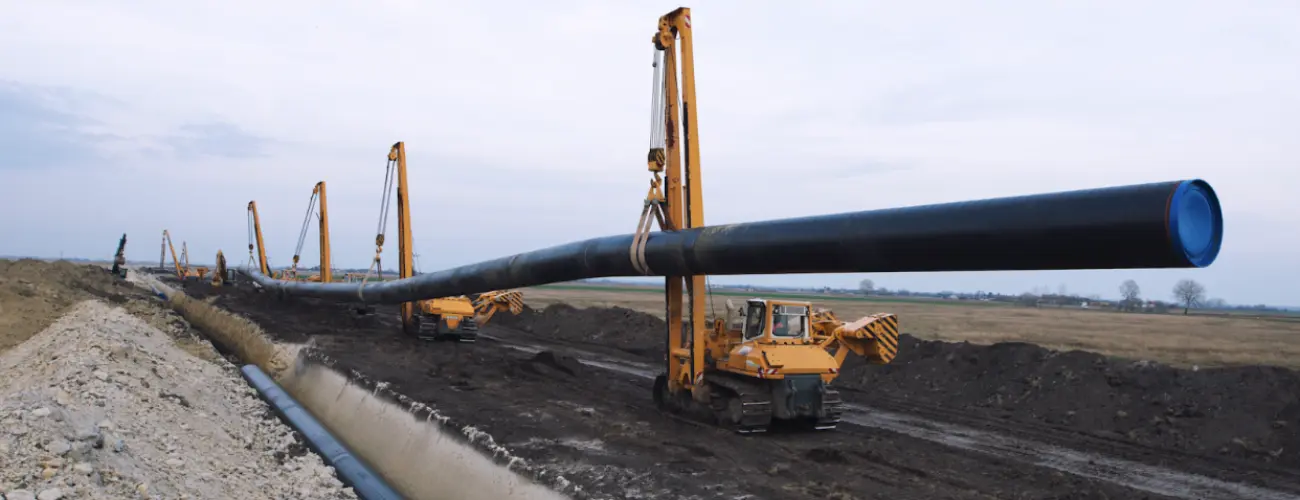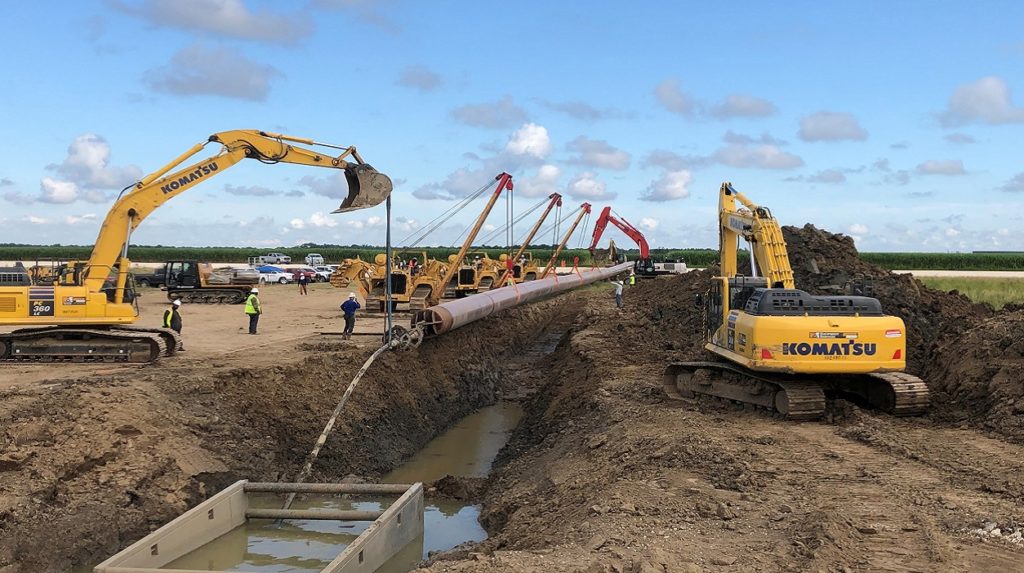Boost Efficiency With Strategic Creek Pipe pipeline construction Methods
A Deep Study Pipes Installation: Essential Variables and Factors To Consider for Successful Projects
Reliable pipe installation is a vital facet of engineering projects. It involves a series of elements, from product selection to exact sizing and design. Each choice can significantly influence the system's performance and durability. Understanding these parts is essential for staying clear of expensive blunders. Creek Pipe contact. As groups navigate through the complexities of installation, a number of vital considerations emerge that warrant interest. What are the pivotal elements that can make or break a piping project?
Comprehending Pipe Materials and Their Applications
When selecting pipe materials, one should think about the specific applications and environmental problems they will certainly face. Various materials supply distinct properties that accommodate various demands. As an example, PVC is lightweight and immune to deterioration, making it ideal for water circulation systems. Conversely, steel pipes offer strength and durability, ideal for high-pressure applications yet might require protective finishings to avoid rust.Copper pipelines are favored for pipes due to their antimicrobial homes and ease of installation, while polyethylene is usually made use of in underground applications because of its flexibility and resistance to cracking.The option of material additionally depends upon temperature level extremes, chemical exposure, and installation location. For high-temperature applications, materials like CPVC or PEX can be helpful. Inevitably, comprehending the qualities and limitations of each material aids in making informed decisions that enhance system efficiency and longevity.
Relevance of Appropriate Sizing and Design
Correct sizing and style of pipes are vital for guaranteeing suitable flow rates and reducing pressure loss. These elements additionally play a significant role in identifying the compatibility of products used in the installation. An organized method to sizing and layout can significantly enhance the efficiency and durability of a piping system.
Influence on Circulation Prices
Circulation prices in piping systems are seriously influenced by the sizing and style of the pipelines. Appropriately sized pipes ensure that the liquid can relocate efficiently, decreasing disturbance and making best use of circulation ability. Oversized pipes can lead to decreased flow speeds, while undersized pipelines might restrict circulation, resulting in increased friction and potential clogs. The layout should additionally take into consideration aspects such as pipe material, internal surface area level of smoothness, and design, as these contribute to the total efficiency of liquid transportation. In addition, the arrangement of installations and connections within the system can affect circulation prices. Careful attention to pipe sizing and layout is vital for maximizing circulation efficiency in any piping installation task.
Pressure Loss Factors To Consider

How can press loss substantially influence the effectiveness of a piping system? Pressure loss is a vital aspect that can significantly reduce the performance of liquid transportation systems. When pipes are poorly sized or created, extreme stress loss may occur, leading to reduced circulation rates and raised power intake. This inefficiency can lead to higher operational costs and potential system failings. Appropriate sizing and design are necessary to minimize pressure loss, guaranteeing that fluid dynamics continue to be ideal throughout the system. Engineers need to very carefully think about variables such as pipe size, size, and product to achieve an efficient equilibrium. Inevitably, attending to pressure loss during the style phase can improve integrity and durability, making it essential for successful piping projects.
Material Compatibility Aspects
Stress loss is not the only element that can impact the performance of a piping system; material compatibility also plays a significant duty in total performance. Making certain that the materials used in a piping system are compatible with the liquids they will certainly transfer is crucial. Different materials can react adversely to different chemicals, leading to rust, destruction, or contamination. This can inevitably jeopardize the integrity of the system and impact its durability. In addition, proper sizing and style are very important to accommodate thermal expansion and tightening, which can additionally influence product efficiency. Evaluating factors such as temperature level, stress, and chemical make-up is vital in selecting ideal materials, thus enhancing system integrity and lowering maintenance costs in the long-term.
Techniques for Accurate Pipe Installation
Accurate pipe installation is important for guaranteeing system efficiency and durability. Numerous strategies can enhance the precision of this process. Initially, mindful measurement is necessary; installers need to utilize quality devices such as laser levels and tape actions to figure out the exact sizes and angles called for. Next off, correct pipe reducing strategies, like utilizing a pipe cutter instead of a hacksaw, assurance clean edges that promote far better connections. Additionally, the usage of alignment tools, such as pipe jigs, can notably enhance accuracy throughout setting up. It is additionally suggested to consider thermal development; allowing for appropriate spacing and growth joints can stop future imbalances. Lastly, the installation team must follow manufacturer guidelines to abide by details referrals associated with each pipe type. By carrying out these techniques, the chance of leaks and system failings reduces, ultimately adding to a more reliable piping system.
Making Certain Pipe Positioning and Assistance
Appropriate placement and support are critical to the stability and efficiency of any type of piping system. Imbalance can result in raised tension on joints, possible leaks, and minimized efficiency. go to this web-site To ensure correct positioning, it is important to use ideal tools such as laser levels and placement evaluates. These tools help accomplish specific positioning, assuring that pipes are mounted according to style specifications.Support systems have to be designed to fit thermal expansion and contraction, in addition to the weight of the pipelines and their contents. Choosing the ideal type of supports, wall mounts, and braces is crucial. Each should be installed at defined intervals to stop drooping or excessive stress on the pipelines. Normal evaluations complying with installation can assist recognize any kind of imbalances or indicators of inadequate support. By prioritizing alignment and support, one can significantly improve the longevity and capability of the piping system.
Common Installation Mistakes to Avoid

Examining and Assessment for Quality Control
The installation process might appear complete, complete testing and examination are vital to ensuring the lasting reliability of a piping system. Numerous methods are used to evaluate the honesty of the installation, including stress examinations, visual assessments, and non-destructive testing (NDT) strategies. Pressure tests validate that the system can endure functional conditions without leaks, while aesthetic inspections assist recognize any type of noticeable defects in the pipes or joints. NDT approaches, such as ultrasonic or radiographic testing, supply insights into the product integrity without jeopardizing the system.Additionally, recording the testing results is necessary for future reference and conformity with sector standards. This paperwork offers not only as a quality control measure however additionally as a legal safeguard. Inevitably, a thorough testing and examination protocol contributes to the general safety and security and performance of the piping system, ensuring it meets the necessary performance requirements gradually.
Upkeep Tips for Long-lasting Pipe Systems
Maintaining a pipe system requires routine evaluations and monitoring to identify potential issues before they escalate. Implementing effective cleaning techniques is also important for avoiding accumulation that can impede performance. Together, these methods add to the durability and dependability of the piping facilities.
Routine Assessments and Tracking
Regular inspections and tracking are crucial for making certain the long life and effectiveness of pipe systems. Regular assessments can aid determine prospective issues such as leakages, deterioration, or obstructions before they rise right into considerable problems. Applying a routine for routine inspections enables the early detection of damage, allowing timely fixings. Tracking pressure degrees and flow prices can likewise provide beneficial insights right into system performance, ensuring that any type of anomalies are resolved Find Out More immediately. Additionally, making use of advanced modern technologies, such as infrared cams or ultrasonic testing, can boost the evaluation procedure by offering thorough information concerning pipe conditions. Inevitably, consistent surveillance and inspections add to the dependability and resilience of pipe systems, lowering the risk of expensive repairs and downtime.

Reliable Cleansing Methods
Reliable cleaning strategies are vital for maintaining the honesty and functionality of pipe systems. Consistently arranged upkeep, such as flushing systems with water, assists get rid of debris and build-up. For more stubborn blockages, experts frequently advise hydro jetting, which uses high-pressure water to tidy pipe insides completely. Chemical cleansers can also be used but must be picked thoroughly to stay clear of damaging pipes. In enhancement, using tools like pipe cams can assist in identifying issue locations and guaranteeing efficient cleansing. Maintaining appropriate water drainage and staying clear of the disposal of hazardous compounds down pipelines further contribute to longevity. Generally, article regular cleansing techniques not just enhance performance but also decrease the danger of pricey fixings in the future.
Frequently Asked Questions
What Are the Labor Costs Related To Pipe Installation Projects?
Labor expenses for pipe installation jobs differ commonly, affected by aspects like job intricacy, regional wage prices, and needed skills (Creek Pipe Midland). Usually, these expenses can range from $50 to $100 per hour, depending on the labor force entailed
Just How Do Regional Laws Affect Pipe Installation Practices?
Regional policies significantly influence pipe installation practices by developing safety and security criteria, material specifications, and installation methods. Conformity with these laws assurances project safety, ecological security, and adherence to regional codes, ultimately influencing total job success and costs.
What Tools Are Crucial for Pipe Installation?
Crucial devices for pipe installation include monkey wrench, cutters, and fittings. Additionally, sealers, determining tapes, and degrees assure accuracy and longevity. Correct equipment advertises efficiency and adherence to safety and security requirements during the installation procedure.
Exactly How Can Weather Condition Conditions Influence the Installation Process?
Climate condition substantially affect the installation procedure, as extreme temperature levels, rain, or wind can influence material honesty, worker security, and project timelines. Appropriate preparation and scheduling are essential to reduce these possible challenges throughout installation.
Are There Guarantees for Mounted Pipe Systems?
Service warranties for installed pipe systems commonly vary by producer and installation service provider. Usually, they cover issues and workmanship for a given duration, ensuring the system's dependability and giving assurance to the building owner.